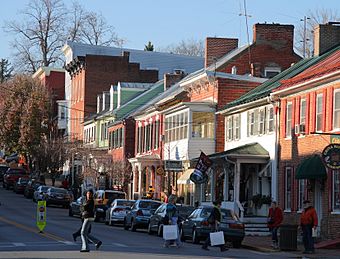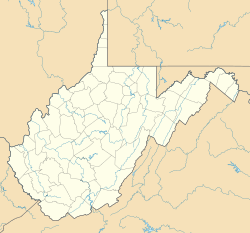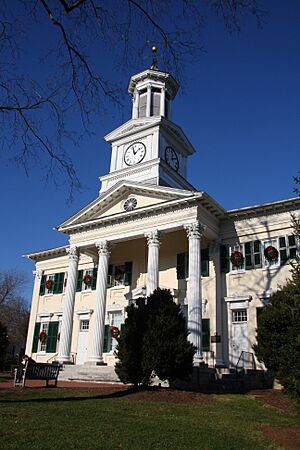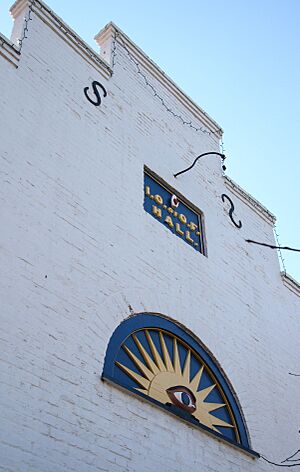Shepherdstown Historic District facts for kids
Quick facts for kids |
|
|
Shepherdstown Historic District
|
|

German Street
|
|
| Location | Shepherdstown, West Virginia |
|---|---|
| Architectural style | Federal |
| NRHP reference No. | 73001920, 87001205 |
| Added to NRHP | August 17, 1973, expanded July 22, 1987 |
The Shepherdstown Historic District is the oldest part of Shepherdstown, West Virginia. This town is the very first one founded in West Virginia! It started in 1762 and was first called Mecklenburg. Even though it's old, we don't know of any buildings still standing from before it became Shepherdstown.
The historic district mainly follows German Street, which is the town's main road. You'll see many brick houses from the late 1700s built in the Federal style. German Street also has cool old things like metal fences, horse mounting blocks, and old wooden water pumps.
Contents
Discover Shepherdstown's Rich History
Shepherdstown has played a big role in American history. It's a place where many important events happened.
Steamboat and Capital Ideas
In 1787, a man named James Rumsey showed off his steamboat right here! He tested it on the nearby Potomac River. Imagine seeing a boat move by steam for the first time!
Later, in 1790, Shepherdstown was even considered to be the new capital of the United States. It was a close race, but the capital ended up being built in Alexandria, Virginia, and Georgetown, Maryland.
Shepherdstown During the Civil War
During the American Civil War, Shepherdstown was in a very important spot. In 1861, Confederate soldiers burned the bridge over the Potomac River. Later, soldiers used a nearby crossing called Pack Horse Ford to move to and from the famous Battle of Antietam.
After this big battle, the whole town of Shepherdstown became a giant hospital. Doctors and nurses cared for many wounded soldiers here. Later, Union soldiers took over the town. They wanted to protect the important railroad link that went west.
Explore Historic Buildings
Many special buildings make up the Shepherdstown Historic District. Each one has its own story!
- Baker House: This brick house from the 1790s is in the Federal style. It has a cool Roman Revival porch. It was once the home of John Baker, who was a US Representative.
- The Great Western Hotel: This building started as a log cabin! It was changed a lot in the early 1800s to become a hotel.
- The Presbyterian Manse: This brick house is also in the Federal style. It was the home of John Kearsley, a very important landowner in the area.
- Trinity Episcopal Rectory: Another Federal style house that was home to John Baker. It was also where Thomas Van Swearingen, another US Representative, lived.
- The Lane House: This Federal style house was once owned by Harriet Lane. She was the niece of President James Buchanan and helped him host events.
- The Sheetz House: During the American Revolutionary War, muskets (a type of gun) were made in this Federal style house!
- The Old Market House: This building was the town's market, built in 1800. It has unique stepped gable ends. In 1845, the Odd Fellows added a second floor. Since 1922, the first floor has been a public library.
- McMurran Hall: This yellow brick building is in the Greek Revival style. It has fancy columns. After the Civil War, it was the courthouse for Jefferson County, West Virginia. Later, it became the first building used by Shepherd College (now Shepherd University).
- The Entler Hotel: This is a very large building with 32 rooms! It is so important that it's also listed on the National Register of Historic Places by itself.
- The Shepherd District Free School: This public school was built in 1868. It's located on the campus of Shepherd University.
- The Chapline-Shenton House: Built in 1793, this house was used as a hospital after the Battle of Antietam during the Civil War.
- The Weltzheimer Tavern: In 1790, the first newspaper in West Virginia was printed here! It was called the Potowmac Guardian and Berkeley Advertiser. Later, in 1808, it became known as Weltzheimer's Tavern.
- Shepherd's Grist Mill: This old mill is also listed on the National Register of Historic Places.
- Billmyer House: This Federal style house was once an inn. It was also the home of Col. John F. Hamtramck, who was important in the Mexican–American War.
Expanding the Historic Area
In 1987, the historic district was made even bigger! It now includes buildings from the late 1800s. These include the Register Building, the Opera House, and the Jefferson Security Bank.
The expanded area also includes Elmwood Cemetery. This cemetery has many graves of soldiers from the Civil War. You can also see houses in styles like American Foursquare and bungalow in the newer parts of the district. Some of the older buildings on the Shepherd University campus are also now part of the historic district.





